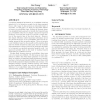Free Online Productivity Tools
i2Speak
i2Symbol
i2OCR
iTex2Img
iWeb2Print
iWeb2Shot
i2Type
iPdf2Split
iPdf2Merge
i2Bopomofo
i2Arabic
i2Style
i2Image
i2PDF
iLatex2Rtf
Sci2ools
SIGMOD
2008
ACM
2008
ACM
Finding frequent items in probabilistic data
Computing statistical information on probabilistic data has attracted a lot of attention recently, as the data generated from a wide range of data sources are inherently fuzzy or uncertain. In this paper, we study an important statistical query on probabilistic data: finding the frequent items. One straightforward approach to identify the frequent items in a probabilistic data set is to simply compute the expected frequency of an item and decide if it exceeds a certain fraction of the expected size of the whole data set. However, this simple definition misses important information about the internal structure of the probabilistic data and the interplay among all the uncertain entities. Thus, we propose a new definition based on the possible world semantics that has been widely adopted for many query types in uncertain data management, trying to find all the items that are likely to be frequent in a randomly generated possible world. Our approach naturally leads to the study of ranking...
| Added | 08 Dec 2009 |
| Updated | 08 Dec 2009 |
| Type | Conference |
| Year | 2008 |
| Where | SIGMOD |
| Authors | Qin Zhang, Feifei Li, Ke Yi |
Comments (0)

